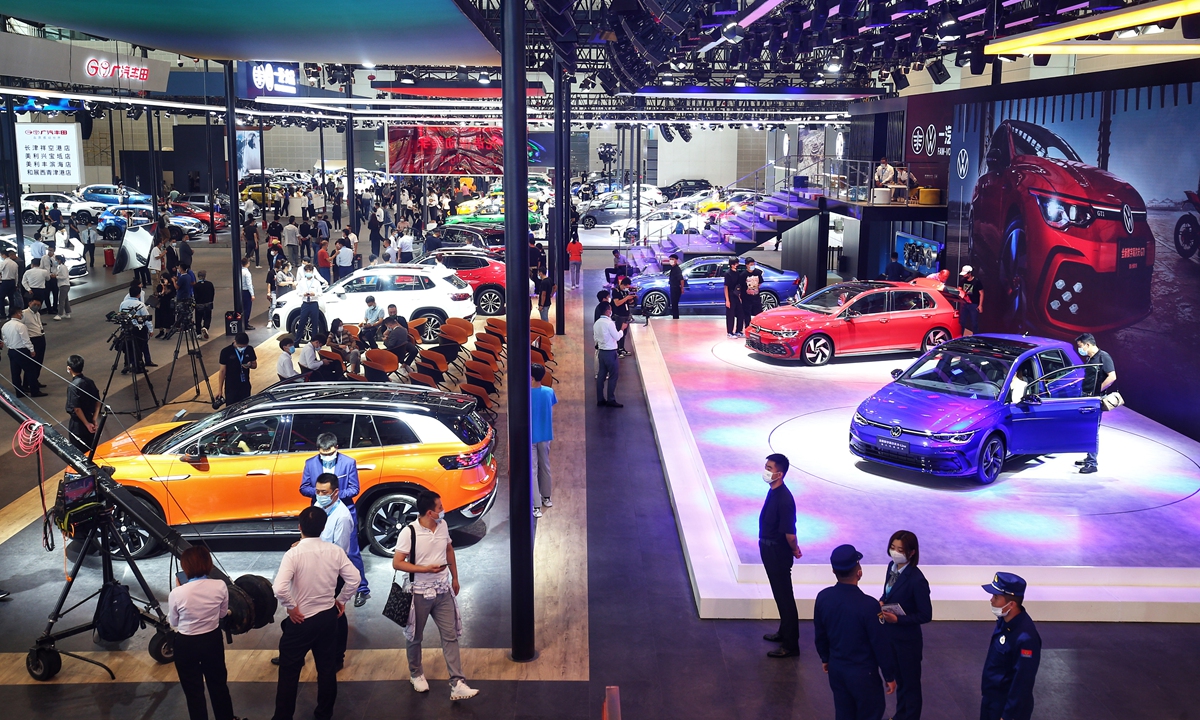
Visitors attend an international auto expo in North China's Tianjin Municipality. Photo: cnsphoto
China's automobile exports reached 352,000 units in October, with the total number of exported cars in the first 10 months up 52.8 percent year-on-year, according to Chinese customs data released on Monday. Meanwhile, the total value of China's auto exports in US dollar terms grew 67.9 percent year-on-year during the period from January to October.
While China's overall trade appears to have been affected by the global economic slowdown, the spectacular growth in China's automobile exports in the first 10 months of this year remains to be testament to the resilience of the Chinese manufacturing sector even amid various geopolitical headwinds.
The automobile industry has always been regarded as one of the hallmarks of a country's manufacturing prowess. Therefore, the remarkable growth of China's auto exports from less than 20,000 units a year in 2000 to become one of the export pillars of the Chinese manufacturing sector is a microcosm of how Chinese manufacturing has managed to move up the value chain from the low end to the middle and high end.
It should be noted that the explosive growth of China's auto exports has much to do with the rapid rise of new-energy vehicles (NEVs). According to statistics released by the China Association of Automobile Manufacturers (CAAM), nearly 4.57 million NEVs were sold in China in the first three quarters of this year, surging 110 percent year-on-year and exceeding the whole-year figure in 2021.
Moreover, Chen Shihua, deputy secretary-general of the CAAM, noted that nearly 10 Chinese carmakers are selling NEVs to Europe, and Chinese electric vehicles now account for 10 percent of those sold in European countries. In early October, German car rental company Sixt committed to buying around 100,000 electric vehicles from China's BYD in the coming years under a new partnership agreement, Reuters reported. The fact that Chinese carmakers can win a relatively big share in the European market, which has advanced industrial and technological strength, in such a short span of time is indicative of the enhanced competitiveness of China's NEV sectors as well as the country's overall manufacturing sector.
From another angle, the increase in China's market share in technology-intensive and higher value-added exports is another proof of the potential and strength of Chinese manufacturing amid global geopolitical headwinds. China's most comprehensive manufacturing system and vast trading partner network has constituted the foundation of the resilience of the Chinese manufacturing, and it is on this basis that some industries have been able to move up the value chain through innovation as well as research and development.
There is no denying that some Western countries have stepped up the US-led containment strategy against China's manufacturing sector, which is in the critical juncture of consolidating its status within the global industrial chain. For instance, when announcing the awarding of $2.8 billion in grants to boost US production of electric vehicle batteries and the minerals used to build them, US President Joe Biden said in mid-October, "China seized a significant portion of the market ... Today we're stepping up... to take it back, not all of it, but bold goals."
The US has been relentlessly trying to crack down on China and boost its own manufacturing sector by rolling out a series of policies aimed at grabbing a bigger share of the international industrial chain. Yet, non-market means cannot change the long-term hollowing-out of the American manufacturing, nor can they contain the development of the Chinese manufacturing industry. Chinese products have been intertwined with the global economy over the past decades, and in the face of a confluence of supply issues, the world needs Chinese manufacturing more than ever.
Chinese carmakers are latecomers in the automobile industry, but they are also pioneers in the NEV sector. Their achievement means that as long as China maintains the strong momentum of technological upgrading and adheres to opening-up and cooperation, no one can stop the Chinese manufacturing industry from moving forward.
The NEV development highlights the Chinese government's goals of promoting green development and deepening energy revolution. China is already a world leader in some new energy areas. China is not only accelerating the pace toward reaching its goal of carbon neutrality, but is also taking advantage of its own manufacturing strength to promote green development around the world. The US may try to curb exports of high-end chips to China, but it cannot stop China from making breakthroughs in broader areas. Quite simply, the US doesn't have the ability to contain China in an all-round way.



